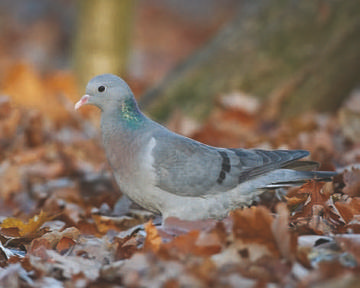
Stock Dove © Richard Steel
Stock Doves were recorded in 49 fewer tetrads in winter than during the breeding season, perhaps because some birds move to join flocks. There are noticeable gaps in the Wirral peninsula, and in the centre of the county around Winsford in SJ66, and they seem to withdraw from the highest altitudes, as was reported in the national BTO Winter Atlas. Stock Dove flocks are seldom as large as those of Woodpigeons, although they sometimes join them and form mixed flocks. The median count of Stock Doves was four birds, with 16 flocks of 50 or more, the biggest being 200 at Capenhurst (SJ37R) and Frodsham Marsh (SJ57E). Their roosts are less noticeable, being reported in only three tetrads, two of them in single figures but that at Fiddler’s Ferry (SJ58M) holding up to 150 birds. From mid-January onwards, some birds were seen in pairs prospecting suitable nest sites.
In winter, many Stock Doves shift habitats to farmland, which makes up 72% of the winter records, including 9% in stubble. This is one of the few species to take advantage of maize stubble, commented upon by observers in twelve tetrads. Far fewer (20%) were in woodland, with only 3% of codes from human sites, and 2% from saltmarsh. Stock Doves feed mainly on weed seeds, although it is almost impossible to see what they are taking when foraging in a field. They especially favour slurried fields and manure heaps, with birds also reported from game cover, rape, sprouts, cattle and horse pastures and paddocks, and a field of improved grassland left to go to seed.
As with Woodpigeon, the migratory status of the winter flocks has been in doubt. Coward (1910) thought that ‘apparently the numbers are increased in winter by immigrants’, and Hardy (1941) described them as a winter visitor in small flocks. Boyd (1951) said they were sedentary, found throughout the Great Budworth district at all times of year in woods and hedgerows and feeding in the fields, often in company with Woodpigeons. Bell (1962) wrote that there was no evidence of migration, probably meaning that birds were not seen flying past Hilbre, but noted that sizeable flocks, between 50 and 100, had been reported frequently in autumn, and again in February in hard weather. Analysis of the national database of ringed birds now shows that British Stock Doves are indeed sedentary, with a median distance of movement of 6 km, and only four birds have shown movements over 200 km, three of them to France or Spain. Three foreign-ringed birds have been found in southeast England (Migration Atlas).
Sponsored by Syngenta CTL

